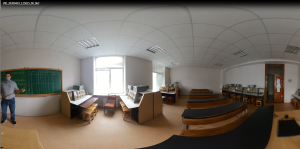22.04.2020
The challenge associated with the COVID-19 pandemic has led to the fact that distance education methods have become essential in the context of forced quarantine and self-isolation of participants in the educational process.
At Kharkiv National University of Radio Electronics, teachers of the Department of Biomedical Engineering fully provide for the distance learning process. In the process of such learning, the possibility of delivering diverse e-learning material and ensuring continuous communication between teachers and students in video conferencing are foregrounded.
Distance learning should allow students to perceive information at different rates based on each individual’s capabilities. One important feature of distance education is the ability to teach students with disabilities. This training in particular will be effective in the first stages of rehabilitation, as the student may feel like a full participant in the learning process. This feeling is reproduced by the virtual presence in the teaching audience with their academic group. This effect can be achieved when using panoramic video with presence effect. Special equipment, such as 360º cameras with high resolution (not less than 4K), is used, allowing for dynamic image zooming without significant loss of quality and a rasterization effect. The peculiarity of panoramic educational content is that the student is not connected by a clearly operator-centric video, but may change the direction of view and zoom in during the viewing process.
This makes it easier for people with disabilities to integrate into the learning process. Also, the benefit of such panoramic content is the flexibility to adjust the pace of learning, the number of repetitions of training material and its viewing from a viewpoint focus on different objects of the environment, which gives the effect of presence in the audience and thus allows the teacher and students to adapt the learning process accordingly to the needs of a particular student or group, which is particularly important in inclusive education.
When using panoramic content, the student, while at home, has the opportunity, either through standard personal computers, or through a mobile phone or tablet (moving his gadget out of the way), to see what is in the learning audience in the appropriate directions. The student has the opportunity to observe at the same time the teacher, for example, explaining the laboratory work near the studied layout, the submission of management commands and processing of data on the monitor screen, auxiliary materials displayed on the board, accessories. Creating quality educational panoramic content is time-consuming, but it can increase the efficiency of the educational process, especially in quarantine conditions, and facilitate the social adaptation of people with special educational needs when implementing inclusive education.
Examples of creating a modern panoramic video with a presence effect for educational content at the BME Department:


